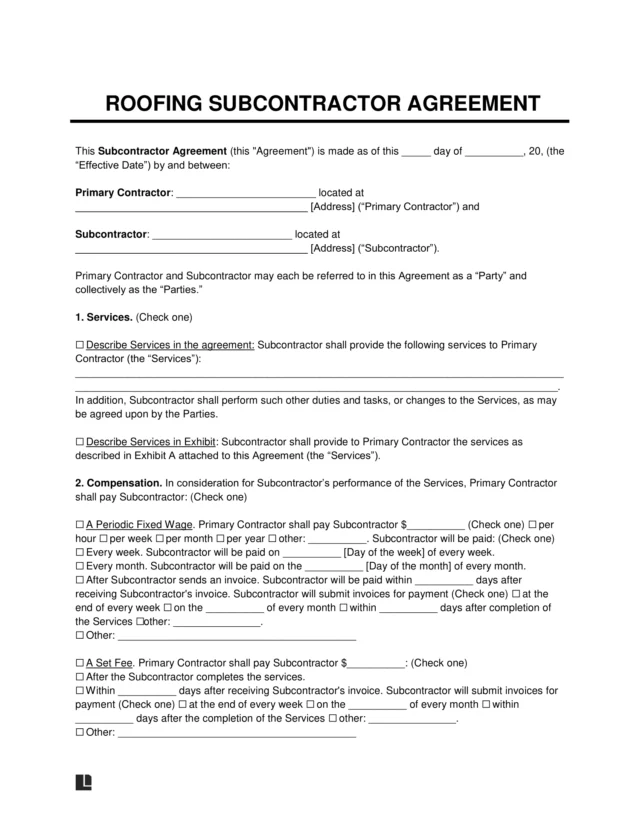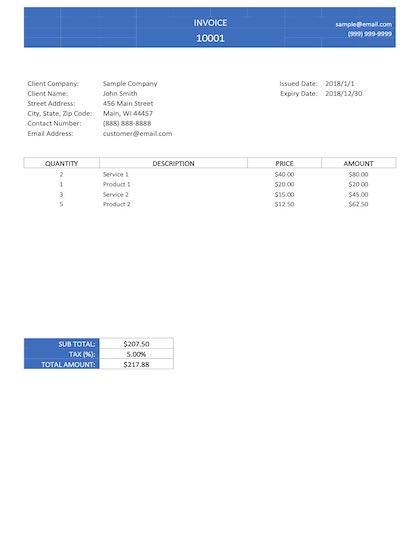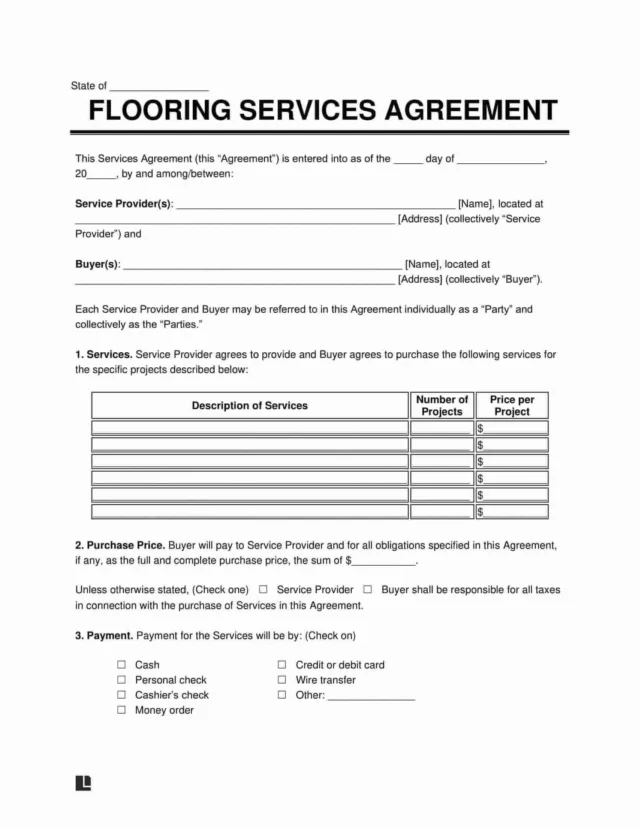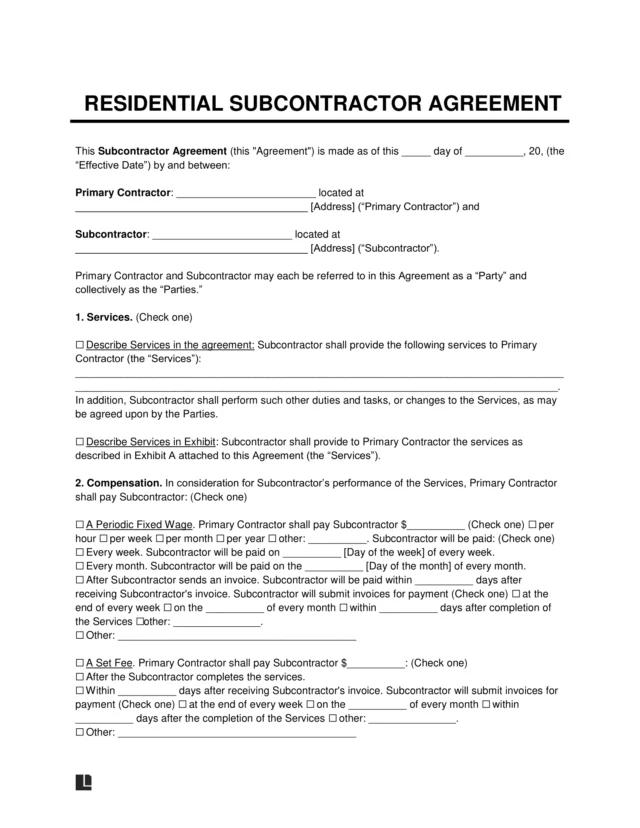What Is a Roofing Contract?
A roofing contract is a written agreement for roof repair or replacement services. It is a legally binding document that details important aspects of the deal, including costs and materials.
Putting together a detailed roofing contract to outline what the parties have agreed to should be the first step before any work is done to repair or replace a roof.
Why Use a Roofing Contract?
- Clarity: This document establishes both parties’ expectations regarding the project’s costs, timelines, materials, and scope. It prevents the client from engaging in scope creep, which is expecting the roofing company to perform more work than what’s in the agreement.
- Legal Protection: Both the roofer and the client receive legal protection, ensuring they can enforce the agreement’s terms if disputes arise.
- Professionalism: This document lets the roofing contractor highlight their professionalism and instills trust in the client.
- Quality Assurance: Roofing contracts often have provisions for guarantees and warranties, ensuring the roofing contractors are accountable for the quality of their workmanship and materials.
What to Include in a Roofing Contract
A standard roofing contract includes the following elements:
- Parties Involved: List the parties involved, including their names and contact information. Distinguish the roofing company from the client.
- Scope of Work: Clearly outline the specific roofing services and tasks the contractor will provide, including roof installation, repair, or replacement. While many roofing contractors will clean up their worksite when done, they may specify this offering in the agreement for added clarity.
- Materials: Clarify the type and amount of materials the roofing contractor will provide.
- Timeline: Define the start and end dates of the assigned work. Detail any milestones or deadlines for the project to manage expectations and ensure timely completion.
- Payment: Record the total expected cost of the project. List the payment schedule, security deposit requirements, and penalties for late payments. The contractor can charge the client via a roofing invoice.
- Warranty: Include guarantees or warranties that the manufacturer or contractor will provide for the materials and workmanship. These provisions ensure the new roof’s longevity and quality.
- Permits and Inspections: State which party must obtain the necessary permits. Address compliance with zoning regulations, permit requirements, and local building codes. Record the guidelines for an inspection once the contractor completes the work.
- Insurance: Name the contractor’s workers’ compensation insurance and general liability insurance to protect both parties in case of damages or accidents.
- Approvals: Specify if the homeowner needs to obtain any approvals, such as approvals from their homeowner’s association or their local architectural review board.
- Termination/Suspension: Describe the conditions under which either party can suspend or terminate the contract. Include termination reasons, notice periods, and any associated fees or penalties.
- Signature Lines: Ask that the parties sign the written contract on the provided lines.
How to Hire a Roofer
If you’re a homeowner who needs to hire a roofer, you can follow these steps to find one:
Step 1 – Conduct Research and Gather Recommendations
Conduct research on roofing contractors in your area. Use websites like the Better Business Bureau (BBB), Angi, and Nextdoor. Ensure the contractors you put on your list are well-established in your area.
Step 2 – Verify Their Insurance Coverage and Credentials
Discover if the roofing contractors have the appropriate credentials and licenses. For example, you can learn if they have certification from the National Roofing Contractors Association (NRCA). Other certifications to look for in roofing contractors are those from CertainTeed or GAF.
While national certifications are important, you should also determine if the contractor is licensed in your area. Contact your local city building department to clarify this information, including their license to work and insurance coverage.
Step 3 – Request Multiple Quotes
Request multiple quotes from various contractors to determine which ones fall into your budget and service expectations. Be wary of low-ball offers and offers that are too high for the normal ranges in your area.
Step 4 – Check References and Reviews
Ask the roofing contractors for references and reviews from former clients. Then, contact the clients to discuss their experiences with the roofing contractors, including their timeliness, professionalism, attention to detail, and willingness to adapt.
Step 5 – Review the Contract
Settle on one roofing contractor and work with them to devise a contract. Engage in negotiations as appropriate.
Review the final draft for details like material and labor costs, timelines, and deliverables. Ensure their scope of work aligns with your needs and preferences. Once you’re satisfied with the document’s terms, you can sign the document and enter the agreement.
Step 6 – Engage in Clear Communication and Monitor Progress
Maintain clear communication with the contractor, ensuring they are updated on changes in the scope of work. Monitor their progress to ensure their quality is up to par. Bring any issues to their attention as soon as they arise so you can move the project’s progress forward.
Step 7 – Perform a Final Inspection and Issue Payment
Perform a final inspection once the contractor finishes their work. Ensure the final product meets the standards that the original contract describes. Issue their final payment once they’ve met all contractual obligations.
State Licensing Requirements
Here are the licensing requirements roofers must meet in each state:
| State | License Required? | Statute | State Licensing Board | Insurance Required? |
|---|---|---|---|---|
| Alabama | Yes. Specifically, commercial contractors with bids higher than $50,000 and residential contractors with bids higher than $10,000 must be licensed. | Ala. Admin. Code r. 230-X-1-.02 | Alabama Licensing Board for General Contractors | Yes (General liability and worker's compensation insurance). |
| Alaska | Yes. Commercial roofing contractors must have a license from the state board. Residential contractors must complete classes with the Alaska Craftsman Home Program (ACHP). | 12 Alaska Admin. Code § 21.020 | Alaska Division of Corporations, Business, and Professional Licensing | Yes (General liability and worker's compensation insurance). |
| Arizona | Yes. The contractor must seek a specialty license. | Ariz. Rev. Stat. § 32-1121 and Ariz. Rev. Stat. § 32-1122 | Arizona Registrar of Contractors | Yes (General liability and worker's compensation insurance). |
| Arkansas | Yes. They must have a license for any residential project exceeding $2,000 and any commercial project greater than $50,000. | Ark. Code § 17-25-604 | Arkansas Contractors Licensing Board | Yes (General liability and worker's compensation insurance). |
| California | Yes. They must have a license for any project exceeding $500. | Title 16, Division 8, Article 3 | California Contractors State Licensing Board | Yes (General liability and worker's compensation insurance). |
Roofing Contract Sample
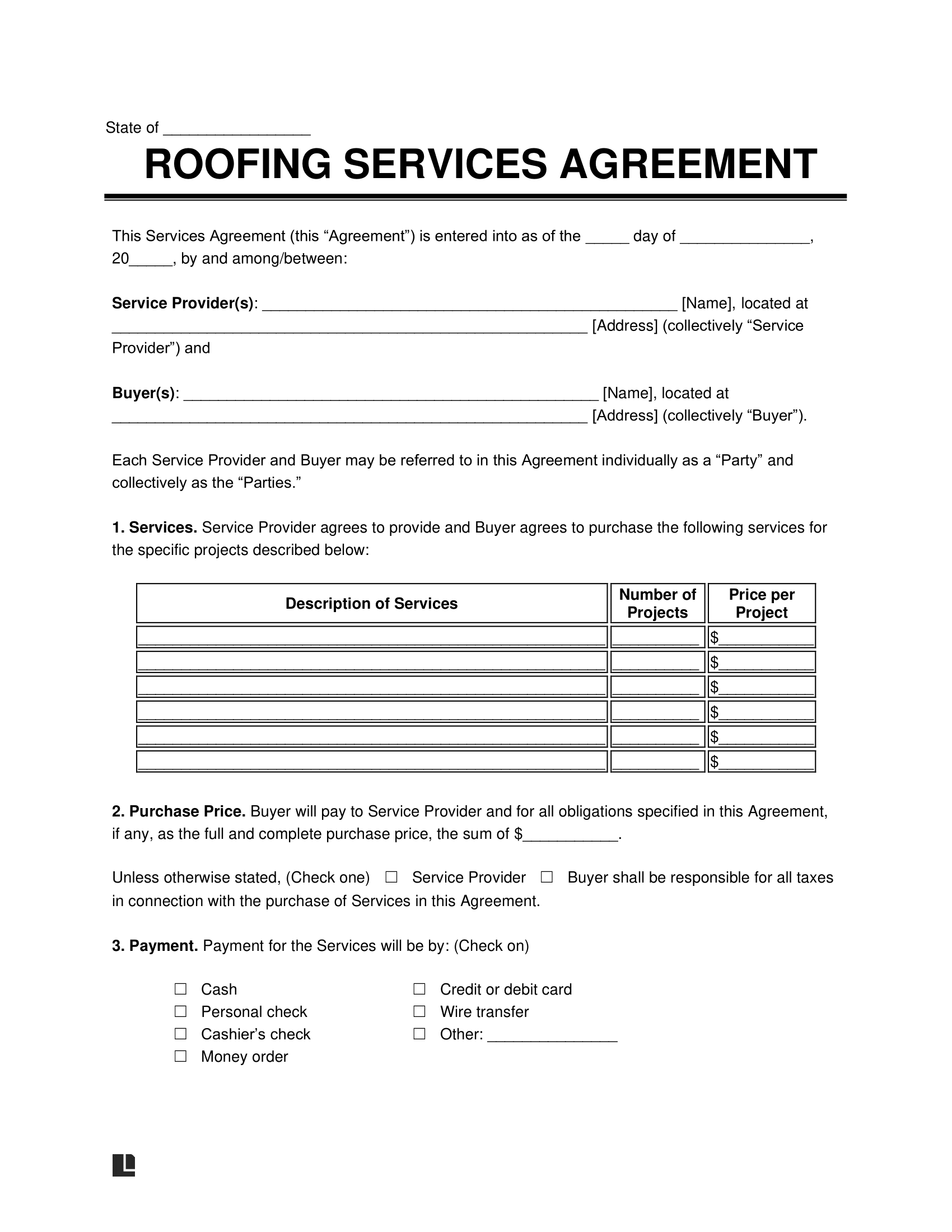
Frequently Asked Questions
What services can I use a roofing contract for?
Use a roofing contract to outline the provision of the following services:
- Roof repair
- Roof replacement
- Roof installation
- Roof maintenance
- Roof cleanup and disposal of old materials
How much does a roofing contractor make?
A roofing contractor’s salary depends on various factors, including the number of projects they take, the size of their company, their reputation, experience level, and location. Please note that their income can vary depending on fluctuating factors, such as competition within the local market, economic conditions, and seasonal demand.
How do I quote a roofing project?
Talk to the homeowner to discuss the scope of work they’d like you to complete. Then, inspect the roof to understand its condition and the work it requires. Measure the roof to estimate the roofing material, labor, and overhead costs. Add a reasonable markup price for your services, accounting for the standard prices in your area.


